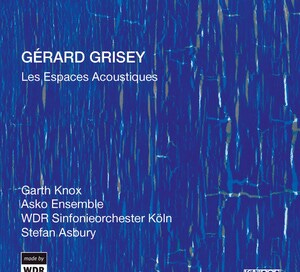THE GENRE PROJECT - January 16 - Spectralism
Genre of the Day - Spectralism
Album of the Day - Les espaces acoustiques by Gérard Grisey
We didn’t even get two weeks after the horrifying experience of serialism until the randomizer spat out yet another strange, impossibly nerdy, unlistenable-to-99%-of-the-population movement of 20th century classical music. This is interesting stuff, for sure, but I must say there is a sharp contrast between listening to the 3-7 minute tunes characterized with essentially every other genre from pop to dance to jazz to regional music and 20 minute suites building up to over an hour and a half of music that makes you feel like you are on the precipice of a horrific death.
When I heard the terms spectralism and spectral music, I expected cool, ghostly music just like the word spectral would imply. Unfortunately, though, it is not. It’s still cool conceptually, though: spectral music developed in the 1970s and focuses on the spectra, i.e. the waves, of music as a foundation for composition. Thus, looking at the sonographic representations of the sound waves informs the composition choices. Like serialism, the genre’s proponents have said many a pretentious thing about its nature (“an aesthetic rather than a style”, “a recognition that music is ultimately sound evolving in time”) but it’s essentially, like serialism, a methodologically revolutionary and mathematical approach to manipulating sound. However, it opposes serialism’s focus on pitch in favor of studying timbre and tone more.
This yields interesting results on RYM’s number one spectralism album, Gérard Grisey’s—a pioneer of the movement—Les espaces acoustiques, a collection of his most important works over around a decade. Each song clocks in at an average of around 16 minutes, but one thing I liked conceptually about the album is that over the course of 6 songs the amount of instrumentalists playing gradually increases, allowing the listener to explore spectralism in a variety of settings. The first song is absolutely horrifying—a lonely atonal viola folds into itself in hair raising fashion at the 10 minute mark, like a musically sketched out rendition of a horrific train crash. The album never reaches this level of sinisterness again, but the tension and frenzied release of the grand orchestra Transitoires comes close.
Overall, I appreciated this album more than serialism because there is more variation in sound, especially in the pacing of songs. The songs oscillate and unfold generally between beautiful, calmer moments such as the beautiful flute midway through Partiels, allowing the listener to take in the climactic, more frightening moments with more appreciation. As fear-inducing as this music is, though, I always welcome learning more about music and thinkers that are willing to play with sound and expand our definition of it. There’s lots of cool moments when looking more into this album—reading tends to expand my appreciation of the music at hand, but this genre needs about five times as much. And that’s okay! Timbre appreciators come one and all to this music—I’m sure you’ll be able to listen and relisten more than I can imagine myself to.




